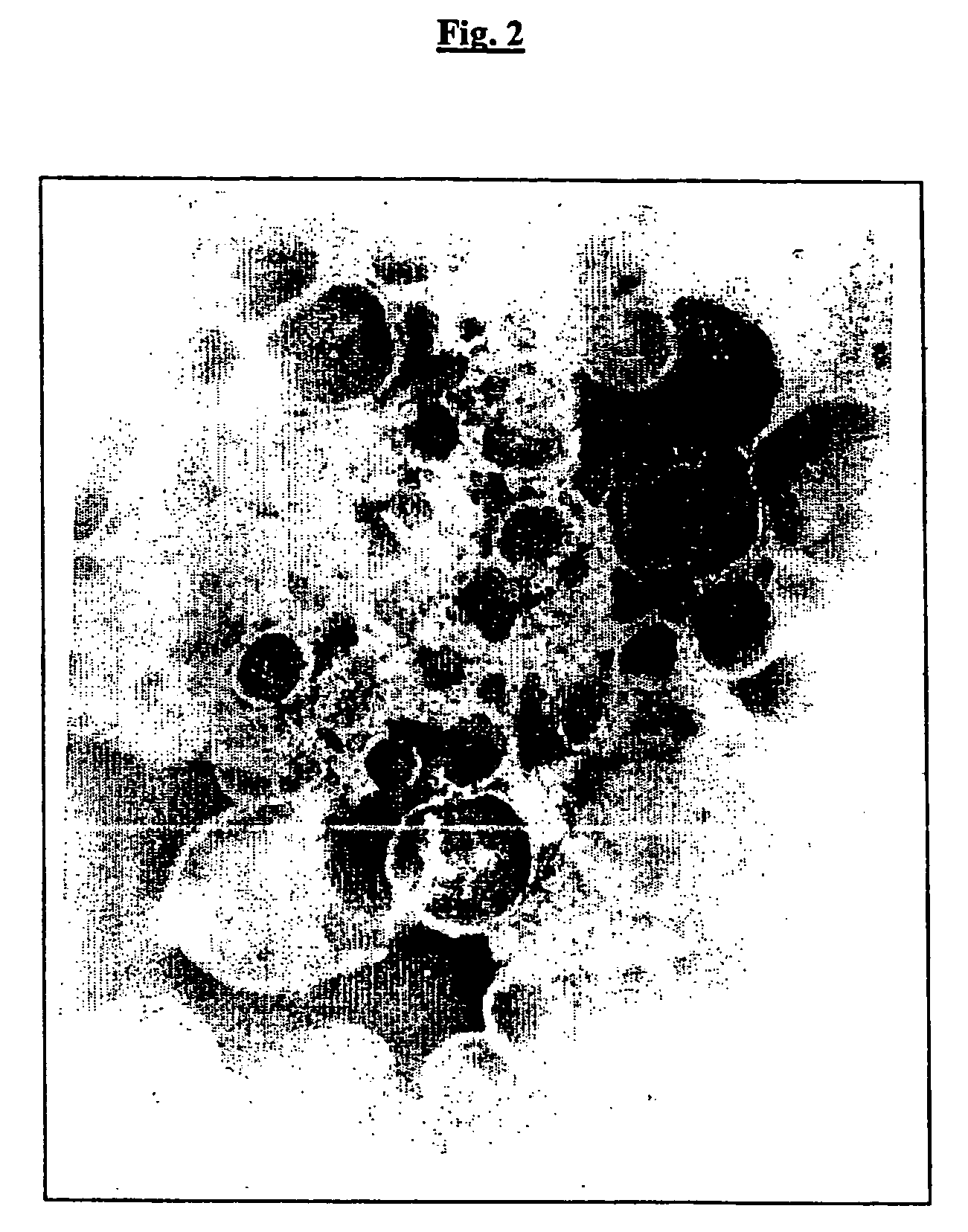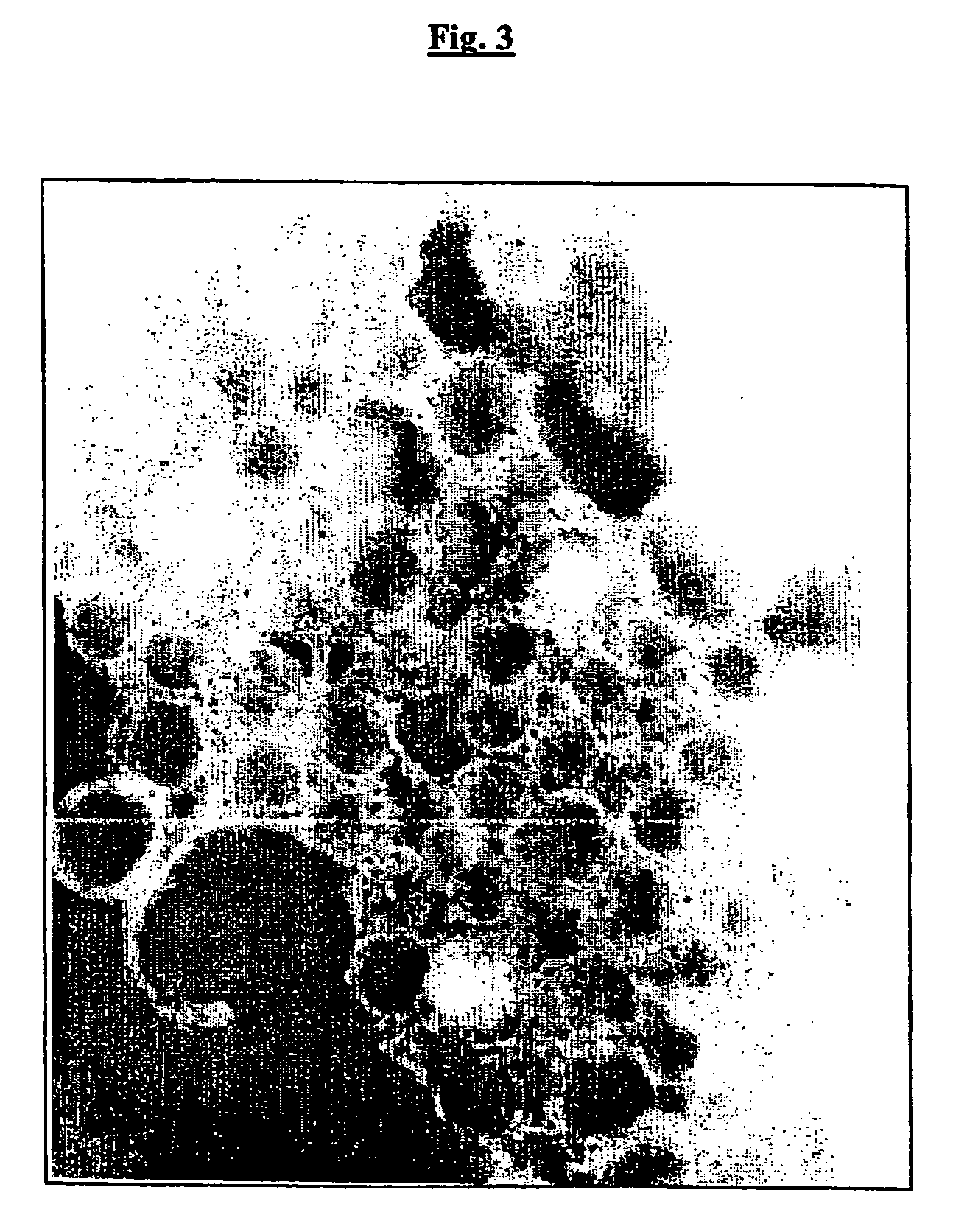Outer membrane vesicles from gram negative bacteria and use as a vaccine
- Summary
- Abstract
- Description
- Claims
- Application Information
AI Technical Summary
Benefits of technology
Problems solved by technology
Method used
Image
Examples
example 1
Deoxycholate Extraction to Produce OMVs
[0098]This method is based on that used to produce the Norwegian Institute of Public Health OMV vaccine for parenteral delivery (Fredriksen, J H et al. (1991) Production and characterisation of menB-vaccine “Folkehelsa”: an outer membrane vesicle vaccine against group B meningococcal disease. NIPH Annals 14 (2): 67B 80).
Reagents
[0099]Frantz medium[0100]Buffer 1: 0.1M Tris-HCl pH8.6 containing 10 mM EDTA, 0.5% (w / v) deoxycholate (DOC), 0.01% (w / v) thiomersal.[0101]Buffer 2: 50 mM Tris-HCl pH8.6 containing 2 mM EDTA, 1.2% (w / v) DOC, 20% (w / v) sucrose, 0.01% (w / v) thiomersal[0102]Buffer 3: 50 mM Tris-HCl pH8.6 containing 3% (w / v) sucrose, 0.01% (w / v) thiomersal
Method[0103]1. Appropriate N. meningitidis or commensal Neisseria strains were grown in Frantz medium at 37° C. with shaking until cultures had reached early stationary phase.[0104]2. Once cultures reached early stationary phase the culture was stored overnight at 4-8° C.[0105]3. The culture...
example 2
Tris-HCl / EDTA Extraction to Produce NOMVs (Native OMVs)
[0114]This method is based on that used by N. B. Saunders et al. (Immunogenicity of intranasally Administered Meningococcal Native Outer Membrane Vesicles in Mice. Infection and Immunity (1999) 67 (1): p.113-119). OMVs prepared in this way have been used as an intra-nasal vaccine in human volunteers.
[0115]Stock NOMV buffer: 0.15M NaCl, 0.05M Tris-HCl, 0.01M EDTA pH 7.5.
Method[0116]1. The culture (Fe limited) was prepared in 500 ml Frantz medium per strain.[0117]2. Cells from the 500 ml culture in step 1 were centrifuged at 3500 rpm for 15 minutes.[0118]3. Cells were resuspended in 25 ml NOMV buffer.[0119]4. The suspension was warmed at 56° C. for 30 minutes.[0120]5. The suspension was sheared in Waring blender for 3 minutes (low speed).[0121]6. The suspension was centrifuged at 23,500 g for 20 minutes.[0122]7. The supernatant was retained.[0123]8. The pellet was resuspended in 12 ml distilled water and centrifuged at 23,5...
example 3
Lithium Acetate Extraction to Produce OMVs
[0129]This is a further alternative method of producing OMVs (Hamel, J. et al. 1987. J. Med. Microbiol. 23,163-170).
[0130]Lithium acetate buffer:−200 mM Lithium acetate+5 mM EDTA pH 6.0
Method[0131]1. The broth culture (Fe limited) was prepared in 100 ml MHB per strain.[0132]2. Cells from 100 ml culture were centrifuged at 3500 rpm for 15 minutes.[0133]3. Cells were resuspended in 20 ml Lithium acetate buffer (LiAc)(for 750 ml cultures, resuspend cell pellet in 30 ml LiAc)[0134]4. The suspension was incubated for 3 h at 37° C. with shaking (180 rpm).[0135]5. The cell suspension was then passed through a 21 gauge needle 7 times, alternatively a bead beater can be used.[0136]6. The suspension was centrifuged at 16000 rpm for 20 minutes.[0137]7. The supernatant was carefully recovered.[0138]8. The supernatant was centrifuged at 35,000 rpm for 2 h and the pellet collected.[0139]9. The pellet was resuspended in PBS and stored at 4° C.
PUM
| Property | Measurement | Unit |
|---|---|---|
| Pharmaceutically acceptable | aaaaa | aaaaa |
Abstract
Description
Claims
Application Information
 Login to View More
Login to View More - R&D
- Intellectual Property
- Life Sciences
- Materials
- Tech Scout
- Unparalleled Data Quality
- Higher Quality Content
- 60% Fewer Hallucinations
Browse by: Latest US Patents, China's latest patents, Technical Efficacy Thesaurus, Application Domain, Technology Topic, Popular Technical Reports.
© 2025 PatSnap. All rights reserved.Legal|Privacy policy|Modern Slavery Act Transparency Statement|Sitemap|About US| Contact US: help@patsnap.com



